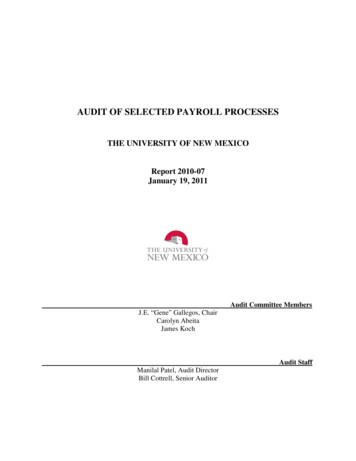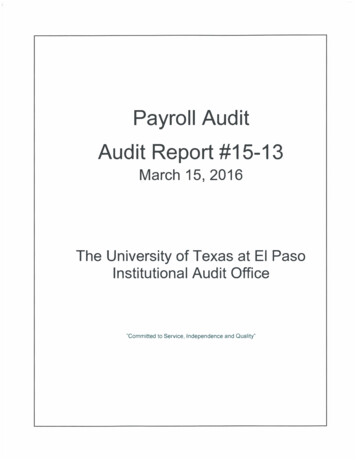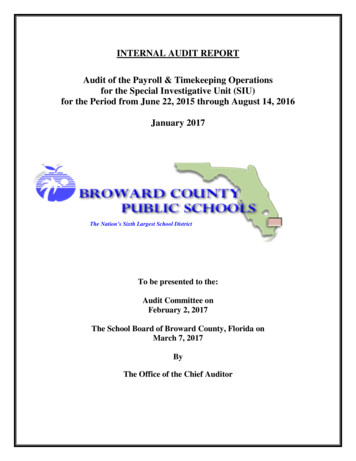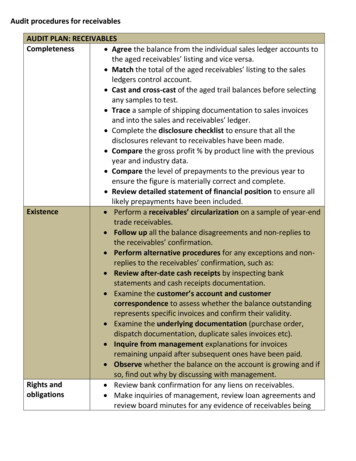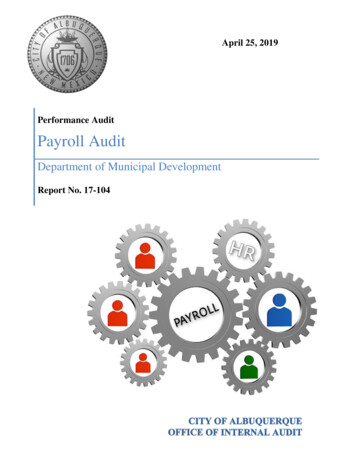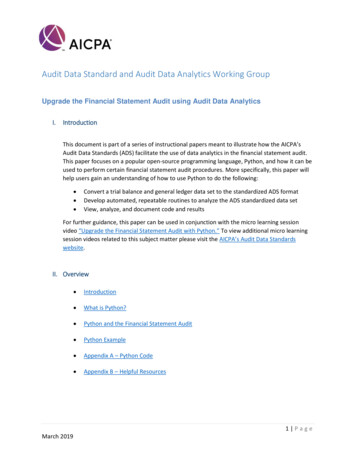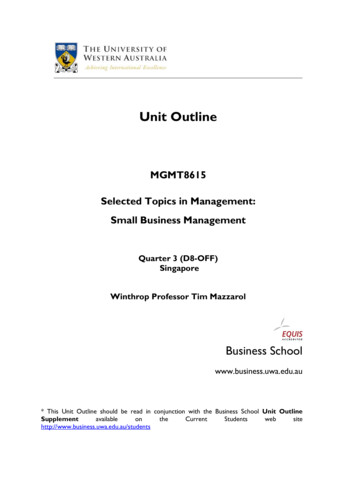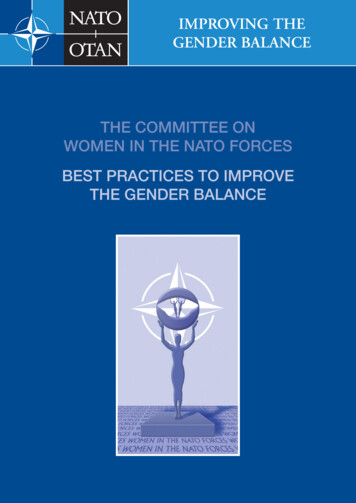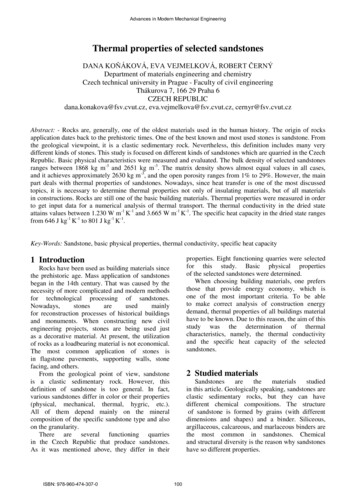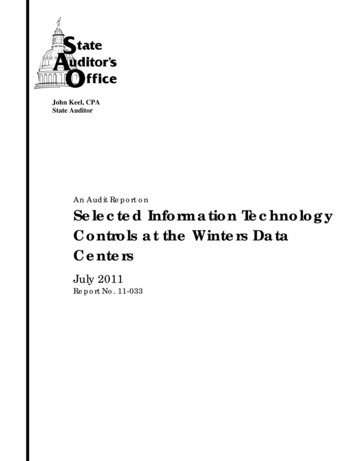
Transcription
John Keel, CPAState AuditorAn Audit Report onSelected Information TechnologyControls at the Winters DataCentersJuly 2011Report No. 11-033
An Audit Report onSelected Information Technology Controlsat the Winters Data CentersSAO Report No. 11-033July 2011Overall ConclusionWeaknesses in the Health and Human ServicesCommission’s (Commission) logical and physicalaccess controls over information technology atthe Winters Data Centers could result in damageto equipment or unauthorized access to and theloss of confidential data and systems.Health and human services agencies rely onmission-critical systems housed at the WintersData Centers to carry out their responsibilities.The weaknesses auditors identified increase therisk of unauthorized access to or loss ofconfidential data.While the Commission has comprehensiveinformation security policies and procedures, itdoes not enforce those policies and proceduresconsistently. It also does not comply with TexasAdministrative Code requirements for passwords,user access, and disaster recovery plan testing.On at least 70 percent of the databases andservers that auditors tested, the Commission’spassword implementation did not meetinformation security standards established forstate data centers. 1Background InformationUnder the requirements of House Bill 1516(79th Legislature, Regular Session), in 2006the Department of Information Resourcescontracted with IBM to migrate existingautomated systems at several state agenciesinto consolidated data centers.IBM then formed Team for Texas, a group ofcontractors that was required to performongoing operations and maintenance and toprovide disaster recovery services fromMarch 2007 through August 2014.This audit focused on information technologycontrols at the Winters Data Centers, whichencompass four distinct data centers thathost health and human services agenciesinformation resources. The Winters DataCenters include: Three data centers (Southeast, Northwest,and Texas Integrated Eligibility RedesignSystem or TIERS) under the responsibilityof the Commission. One data center (Southwest) managed bythe Department of State Health Services.Team for Texas provides ongoing operationsand maintenance for the servers in the abovedata centers, but the Commission and healthand human services agencies are stillresponsible for ensuring the security of theirinformation technology.The Commission does not adequately monitorvendors that provide certain operation andmaintenance services at the Winters Data Centers. The outsourcing of certainoperation and maintenance services to vendors, combined with the Commission’sorganizational structure, has resulted in significant challenges. For example: 1A system of shared responsibilities for information technology now exists amongvendors, the Commission, and health and human services agencies. Staff at theCommission and health and human service agencies have not fully embracedthose shared responsibilities. The complex system of responsibilities requiresgreater oversight by the Commission and health and human services agencies.See additional details on those standards in Chapter 1 of this report.This audit was conducted in accordance with Texas Government Code, Section 321.0132.For more information regarding this report, please contact Ralph McClendon, Audit Manager, or John Keel, State Auditor, at (512) 9369500.
An Audit Report onSelected Information Technology Controls at the Winters Data CentersSAO Report No. 11-033 The outsourcing of certain services, coupled with a lack of oversight by theCommission and health and human services agencies, has resulted in instances inwhich staff were unaware of services and user accounts on their mission-criticalsystems.While vendors perform certain services at the Winters Data Centers, this does notrelieve the Commission or the health and human services agencies of theirresponsibility for ensuring that data and systems are properly secured.Key PointsAuditors identified weaknesses in user access, physical security, and disasterrecovery planning.User Access. The Commission does not adequately secure access to servers,databases, and systems. For example, auditors identified weaknesses in passwordsettings, weaknesses in user access management, and the absence of a regular useraccess review process.Physical Security. Physical security controls at the Winters Data Centers areinadequate. For example, at the beginning of this audit, the doors for two of thedata centers within the Winters Data Centers were not locked because they did nothave working security card readers (the Commission corrected that issue afterauditors brought it to the Commission’s attention). In addition, the process forreviewing the appropriateness of physical access to the Winters Data Centers isineffective, and one fire suppression system has not passed inspection.Disaster Recovery Planning. Disaster recovery plans for the Winters Data Centersare inadequate. System documentation does not contain sufficient detail tofacilitate recovery of systems and data; however, data backups are scheduled androutinely performed.The weaknesses auditors identified increase the risk of service interruption andloss or theft of data.Any of the weaknesses individually places data and systems at risk. Whencombined, these weaknesses significantly increase the risk that services could beinterrupted and the data could be unintentionally or deliberately lost.The weaknesses auditors identified could affect systems that were not audited.This audit focused on seven mission-critical systems that are housed at the WintersData Centers, but the weaknesses auditors identified could affect other systemsthat were not audited. Auditors selected the seven systems based on a riskassessment of mission-critical systems. The seven systems are used by theCommission, the Department of Aging and Disability Services, and the Departmentof State Health Services.ii
An Audit Report onSelected Information Technology Controls at the Winters Data CentersSAO Report No. 11-033To minimize the risk associated with public disclosure, this report does not identifythe systems audited, but auditors provided the Commission and health and humanservices agencies with detailed audit results and other less significant issuesseparately in writing.Summary of Management’s ResponseThe Commission agreed with the recommendations in this report.Summary of Objectives, Scope, and MethodologyThe audit objectives were to: Determine whether selected information technology controls at the Winters DataCenters operate to protect and support the information technology assets of theState’s health and human services agencies. Determine whether selected information technology controls at selected healthand human services agencies operate to protect state information technologyassets.The audit scope included the health and human service agency facilities wherestate technology assets are located, with a focus on the Winters Data Centersfacilities in the Austin health and human services complex. The scope of this auditspecifically covered information technology systems located on servers at theWinters Data Centers based on a risk assessment of confidential information in thesystems and whether the system was identified by the agency as critical tooperations. Audit work included a review of logical security controls related touser access and passwords; a review of physical security controls at the WintersData Centers; and controls related to disaster recovery plans, operations, andsecurity training at selected health and human services agencies. The Departmentof Assistive and Rehabilitative Services and the Department of Family andProtective Services were not included in logical security controls work becausethose agencies did not identify systems as critical in the Winters Data Centers.The audit methodology included conducting an assessment of logical securitycontrols for seven systems housed in the Winters Data Centers by verifying theappropriateness of user access, assessing the strength of password controls, andassessing the process for periodic user access reviews. Auditors interviewed staffat the Commission, health and human services agencies, the Department ofInformation Resources, and the Texas Facilities Commission. Auditors alsoconducted multiple walkthroughs of the Winters Data Centers to assess physicalsecurity, environmental security, and alternate and uninterruptible power supply.Auditors also verified the capability of the Commission to meet state disasterrecovery requirements for systems that are housed in the Winters Data Centers.iii
An Audit Report onSelected Information Technology Controls at the Winters Data CentersSAO Report No. 11-033This audit did not rely on agency data for the purpose of making conclusions.However, auditors used data from the State Data Center Centralized MasterDatabase to assess risk at the Winters Data Centers.iv
ContentsDetailed ResultsChapter 1The Commission Does Not Adequately Secure UserAccess to Servers, Databases, and Systems . 1Chapter 2The Commission Should Improve Physical Security andEnvironmental Controls at the Winters Data Centers . 7Chapter 3Weaknesses in Disaster Recovery Planning and the Useof Outdated Software Could Impair the Commission’sAbility to Recover from an Interruption in Services . 12AppendicesAppendix 1Objectives, Scope, and Methodology . 16Appendix 2Shared Responsibility for Server Operating Systems,Systems, and Databases Audited . 20Appendix 3Interagency Contract Between the Health and HumanServices Commission and the Texas FacilitiesCommission . 21Appendix 4Related State Auditor’s Office Work . 26
Detailed ResultsChapter 1The Commission Does Not Adequately Secure User Access to Servers,Databases, and SystemsAuditors identified significant weaknesses in the Health and Human ServicesCommission’s (Commission) controls at all access levels audited for the sevensystems tested. Those weaknesses place the audited systems at risk ofunauthorized access and loss of data. The 7 systems audited are supported by25 servers and 10 databases, and auditors identified weaknesses in user accessand passwords at the server, database, and system levels.While auditors identified significant weaknesses in user access, they identifiedno weaknesses in segregation of duties in controls related to access.Chapter 1-AThe Commission Does Not Consistently Ensure That PasswordControls Are AdequateSignificant weaknesses in access controls exist at all levels tested. Controllingaccess is necessary for any information resource. If unauthorized entities gainaccess to data and systems, this can harm the confidentiality, integrity, andavailability of data and systems and may result in loss of service, loss of trust,and liability.Summary of InformationSecurity Standards Title 1, Texas AdministrativeFor the servers, databases, and systems tested, auditors identified instances inwhich password requirements did not meet the standards established byCommission policies, Texas Administrative Code requirements, and statedata center information security controls (see text box). Thoseweaknesses exist because of software limitations and a lack of adequateoversight and enforcement of policies and standards. Specifically:Code, Chapter 202, specifiessecurity standards for all stateagencies. The Commission’s Enterprise Information Security Standardsand Guidelines specifies standardsfor all authorized users (includingcontractors and agency staff) ofhealth and human servicesinformation resources. Team for Texas’s InformationSecurity Controls for State ofTexas Data Center Servicesspecifies security standards,policies, and controls.Server Level.The Commission’s enforcement of its password policiesacross servers has been inconsistent. Of the 25 servers tested: Twenty-one servers (84.0 percent) have weak password settings. One server (4.0 percent) does not have any default passwordsettings. That server has 68 user accounts, 37 of which do notenforce password requirements. Of those 37 user accounts, 21have no access limitations and no password requirements. Theremaining 16 user accounts have no password requirements, butthe user has to be physically present at the server to log in.An Audit Report on Selected Information Technology Controls at the Winters Data CentersSAO Report No. 11-033July 2011Page 1
Three servers (12.0 percent) comply with password policies; one ofthose three servers meets best practices but does not comply withCommission policy.The Commission also has filed six exceptions to waive compliance withsome of the password requirements on server accounts related to thesystems audited. Four of the exceptions expired in April 2011 and two arepending approval. Exceptions are an acknowledgement that weakpassword controls exist. The approval of an exception does not mitigatethe risk that passwords could be compromised. The Commission’sexception documents state that “there is an increased risk of the passwordbeing compromised if this exception is granted. If this were to happen, anattacker could temporarily disable these systems.” The exceptiondocuments also note that “user accounts which use weak passwords aremore susceptible to brute force attack.” The Commission has not enforced its password standardsacross databases. Of the 10 databases associated with the systems tested,7 do not meet the Commission’s password standards. System Level.Database Level.Controls for six of the seven systems tested complied withstandards for password composition. The remaining system tested met thespecific standard for changing passwords after a certain time period, but itdid not comply with other password standards.RecommendationThe Commission should ensure that password controls for servers
One data center (Southwest) managed by the Department of State Health Services. Team for Texas provides ongoing operations data centers, but the Commission and health and human services agencies are still responsible for ensuring the security of their information technology. An Audit Report on Selected Information Technology Controls at the Winters Data Centers SAO Report No. 11-033 ii
